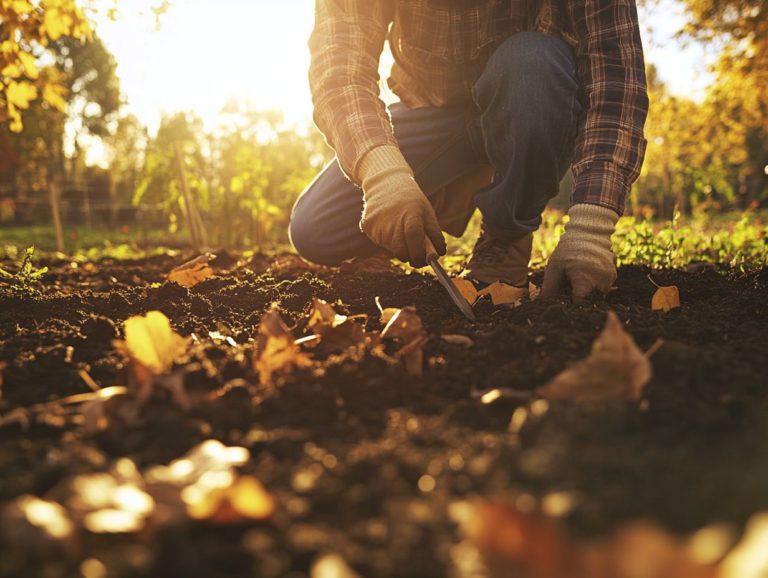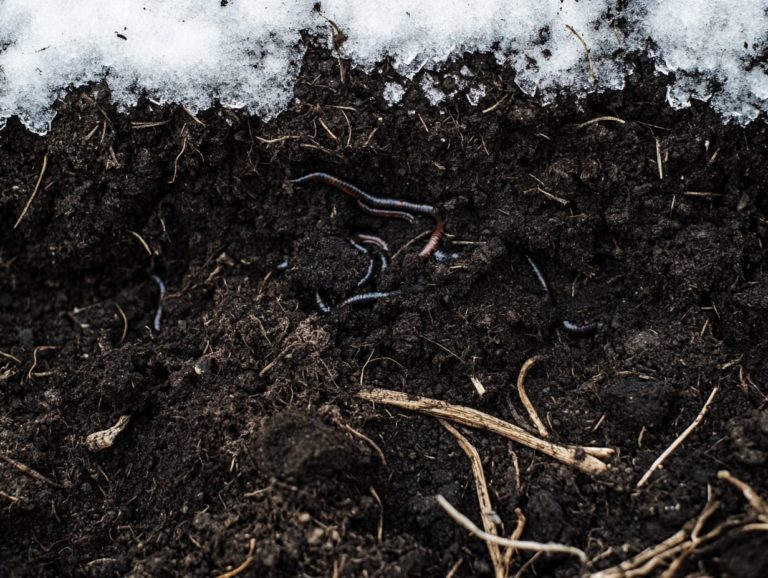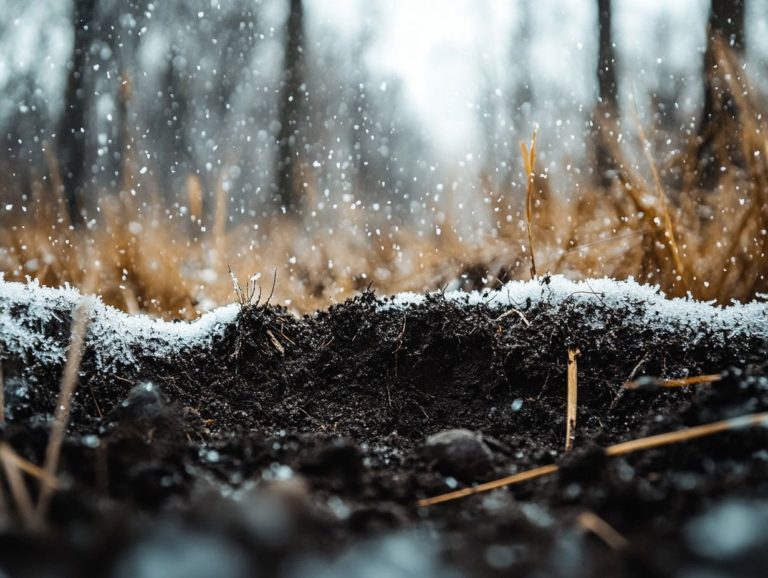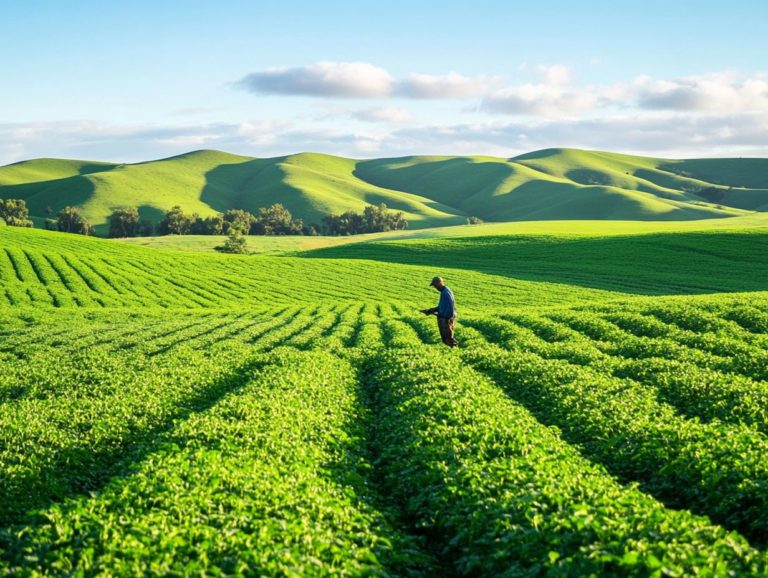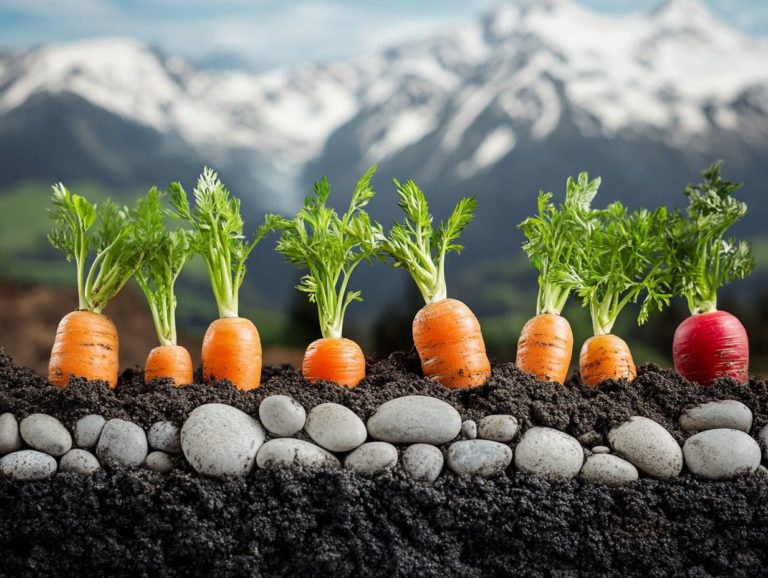How to Build a Soil Profile for Cold Climates
Soil profiles are essential for grasping the health and structure of landscapes, particularly in cold climates where conditions can be quite challenging.
This guide delves into the fundamentals of soil profiles, illuminating their definition and importance in frigid environments. You ll uncover the factors that influence these profiles and gain practical insights on how to build and maintain them effectively.
Whether you re a gardener, farmer, or an environmental enthusiast, this resource will empower you with the knowledge needed to enhance soil health in colder regions.
Contents
- Key Takeaways:
- Understanding Soil Profiles
- Factors Affecting Soil Profiles in Cold Climates
- Steps to Building a Soil Profile for Cold Climates
- Maintaining and Improving Soil Profiles in Cold Climates
- Frequently Asked Questions
- What materials are needed to build a soil profile for cold climates?
- Why is it important to build a soil profile for cold climates?
- At what time of year should I build a soil profile for cold climates?
- How do I determine the appropriate depth for each layer in a soil profile for cold climates?
- What type of soil is best for a soil profile in cold climates?
- Do I need to add any amendments when building a soil profile for cold climates?
Key Takeaways:
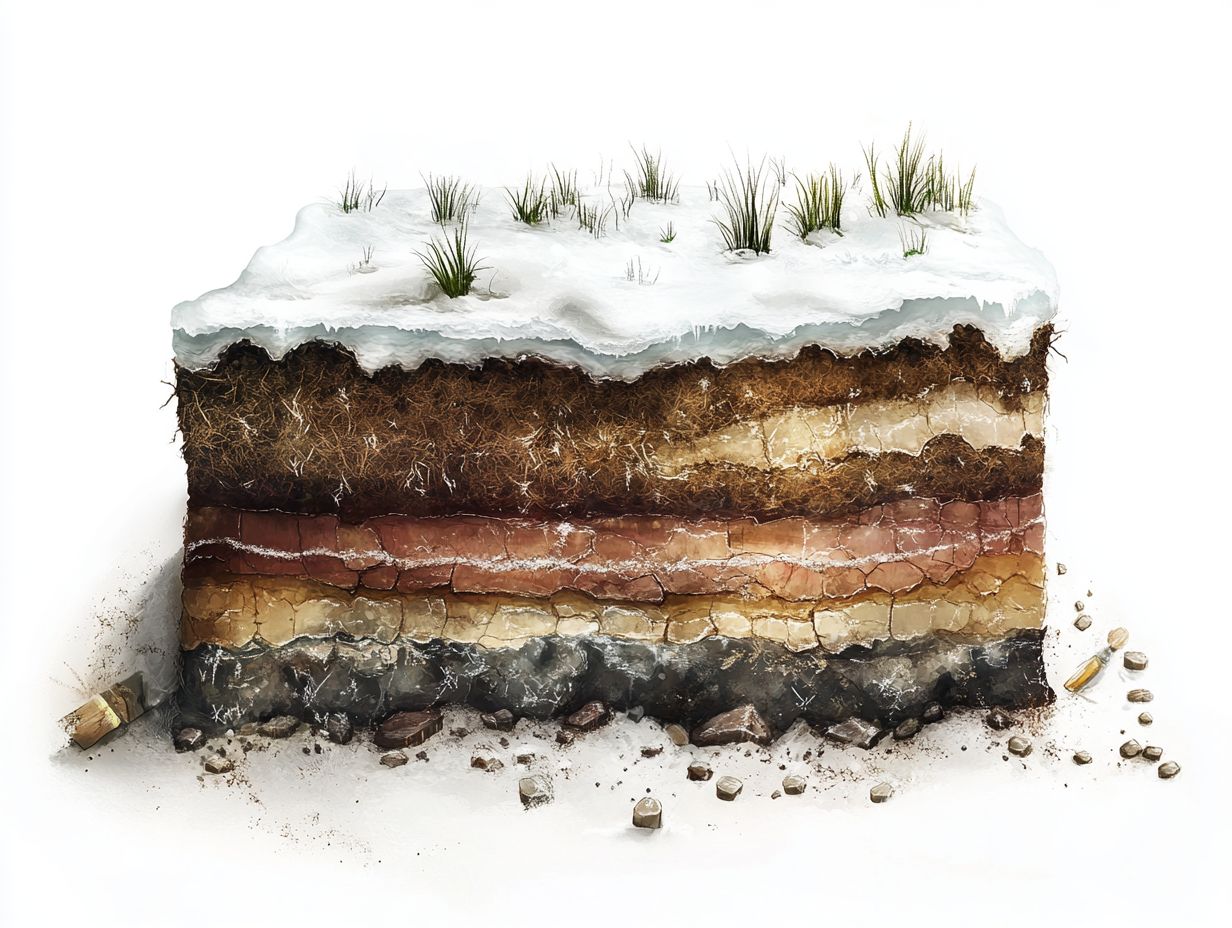
- Understanding soil profiles is essential for effective gardening and farming in cold climates.
- Factors like climate, vegetation, and land use greatly impact soil profiles in cold climates.
- To build a soil profile for cold climates, gather tools, identify soil type, layers, and composition, and make necessary adjustments for the climate.
Understanding Soil Profiles
Understanding soil profiles is essential for your gardening success, especially in cold climates. To thrive in these conditions, it’s important to learn what to know about soil fertility in cold climates, as the characteristics of the soil can make or break your endeavors.
Soil profiles unveil the distinct layers that determine moisture retention, fertility, and nutrient availability all critical for optimal root growth and plant hydration in diverse conditions.
By carefully examining these profiles, you can apply the appropriate drainage techniques, soil amendments, and planting strategies. This creates an ecological balance that supports robust soil ecosystems.
What is a Soil Profile?
A soil profile offers a fascinating glimpse into the vertical section of soil, revealing the distinct layers, or horizons, that stretch from the surface down to the bedrock.
Each layer plays a vital role in shaping soil structure and fertility. At the top, you ll find the topsoil, teeming with organic matter and nutrients essential for robust plant growth.
This layer hosts a vibrant community of microorganisms and earthworms, all working together to enhance its health and richness.
Beneath that lies the subsoil, where minerals start to accumulate and water retention shifts, affecting how accessible resources are for deeper-rooted plants.
Finally, the parent material, the foundational layer, consists of weathered rock and minerals that gradually influence the characteristics of the layers above. By understanding how these layers interact, you can effectively manage land use and promote soil health.
Importance of Soil Profiles in Cold Climates
In cold climates, grasping the intricacies of soil profiles is essential for your gardening success. Understanding these profiles will enable you to assess critical factors like moisture retention and nutrient availability, especially when preparing your soil for spring.
Both are vital for plant survival during the harsh winter months. The extreme temperature fluctuations characteristic of these regions can lead to soil shifting due to freezing and thawing and frost damage.
As a gardener, you must develop effective soil management strategies. By analyzing the composition and layering of your soil, you can pinpoint potential drainage issues that may worsen during cold spells.
This insight enables you to implement techniques such as applying mulch or utilizing raised beds both of which can significantly elevate soil warmth and protect your plant roots from icy conditions.
By adapting to these climatic challenges through thoughtful soil management, you not only nurture healthier plants but also set the stage for a more bountiful harvest when spring arrives.
Factors Affecting Soil Profiles in Cold Climates
Numerous factors influence soil profiles in cold climates, particularly temperature fluctuations, as well as the types of vegetation and land use.
These elements can considerably change soil characteristics and overall fertility, directly affecting agricultural productivity and the success of your garden.
Start building your soil profile today to transform your garden for the coming spring!
Climate and Temperature

Climate and temperature are crucial in shaping soil profiles, especially in cold areas where freezing cycles impact soil characteristics.
Temperature changes can alter soil structure. This affects vital elements like drainage and microbial activity.
When temperatures drop, moisture in the soil freezes and expands. This movement can disrupt drainage patterns, sometimes trapping water and causing waterlogging.
The freeze-thaw cycle boosts microbial activities essential for nutrient movement in the soil. However, extreme temperature shifts can harm soil health and crop yields. Grasping these dynamics is key to thriving gardens!
Vegetation and Land Use
Vegetation type and land use play crucial roles in shaping soil profiles. Different plants can dramatically influence soil composition, fertility, and the activity of essential microorganisms that help nutrients move in the soil.
Recognizing this relationship is key to fostering sustainable gardening practices. For instance, monoculture farming growing a single crop over large areas can lead to nutrient depletion and reduced soil biodiversity, harming soil health.
Conversely, embracing diverse plantings and crop rotations cultivates a more resilient soil ecosystem. This boosts beneficial microbial activity and enhances soil health.
Implementing practices like cover cropping can improve soil structure and reduce erosion. However, excessive foot traffic or heavy machinery can compact the soil, hindering root growth and water infiltration.
Sustainable land management aims to strike a balance among these factors, ensuring that both vegetation and soil continue to support agricultural productivity.
Steps to Building a Soil Profile for Cold Climates
Building a soil profile for cold climates requires a systematic approach. This step is vital to ensure success in your garden, and identifying soil types in cold climates can greatly enhance your efforts, even under tough conditions!
By doing so, you set the stage for optimal garden success, even in challenging environments.
1. Gather Necessary Tools and Materials
To effectively build a robust soil profile, gather essential tools and materials, including soil testing kits, garden spades, and organic amendments like compost and fertilizers.
These tools are crucial for understanding nutrient content, pH levels, and overall soil health. Soil testing kits provide insights that guide you in determining the right amendments for optimal plant growth.
A sturdy garden spade is essential for digging and collecting samples from various depths, allowing for a thorough analysis of different soil layers.
Incorporating organic amendments like compost enriches the soil and fosters vital microbial activity, enhancing overall fertility needed for sustainable gardening.
2. Identify the Soil Type
Identifying the soil type is essential for understanding soil profiles. Each type has distinct characteristics that influence drainage, structure, and overall fertility.
In colder climates, the mix of sandy, clay, and loamy soils significantly impacts how water moves through the ground and the effectiveness of drainage techniques.
Sandy soils, with larger particles, allow for efficient water drainage, helping to prevent issues like waterlogging. In contrast, clay soils, known for their fine particles, retain moisture, which can lead to drainage problems if not managed correctly.
Loamy soils, a balanced mix of sand, silt, and clay, offer the best of both worlds. They provide excellent drainage while retaining enough moisture and nutrients for many plants to thrive.
Understanding these dynamics enables you to choose the right drainage solutions and improve soil structure, fostering healthy growth even in challenging conditions.
3. Determine the Soil Layers

Determining the various soil layers in a profile is essential for grasping their relationship to root growth and water movement.
When you study soil layers, you can identify distinct horizons. The O horizon is the top layer filled with decomposed leaves and plants. This layer plays a crucial role in supporting plant life.
Rich in decomposed organic matter, it enhances nutrient availability and moisture retention critical for root development.
Understanding how soil disturbances like tilling or construction impact these layers is vital. Such activities can lead to compaction, reducing pore space and hindering roots from accessing essential nutrients and water.
Addressing these disturbances is key to maintaining healthy soil ecosystems and fostering robust root systems.
4. Analyze Soil Composition
Analyzing soil composition is essential to identify nutrient deficiencies and ensure the presence of vital organic matter and beneficial soil microorganisms.
This assessment is the backbone of effective farming, empowering you as a farmer or gardener to make informed decisions about necessary soil amendments and fertilizers.
By examining both the chemical and physical properties like pH levels, nutrient ratios, and texture you can tailor your interventions to enhance productivity and support sustainable land management.
Knowing your soil’s unique traits helps you create a thriving environment for crops, ultimately leading to improved yields and enhanced soil vitality.
Making proper adjustments based on thorough analysis can significantly impact your ability to cultivate resilient ecosystems.
5. Make Adjustments for Cold Climate
Adjusting for cold climates is crucial in optimizing your soil profiles. This involves practices like incorporating compost and applying balanced fertilizers.
Layering mulch helps insulate the soil, retaining warmth while minimizing surface evaporation.
Consider introducing cover crops during the off-season. They protect the soil from harsh winter elements and improve its structure and nutrient content when tilled back.
Installing drainage systems, like French drains, or utilizing raised beds can effectively manage excess moisture. This ensures your soil remains well-aerated and conducive to plant growth, even in winter.
Maintaining and Improving Soil Profiles in Cold Climates
Maintaining and enhancing soil profiles in cold climates is essential for securing long-term soil health. For more information on this topic, check out how to test soil nutrients in cold climates. This has a direct effect on the vitality of garden environments and the overall productivity of agricultural endeavors.
Best Practices for Soil Health
Implementing best practices for soil health is crucial for maintaining vibrant soil profiles. This involves using soil amendments, cover crops, and effective erosion control strategies.
- Incorporate cover crops like clover or rye during the off-seasons to reduce soil erosion.
- Improve moisture retention and enhance nutrient cycling.
- Apply organic or inorganic soil amendments, such as compost or lime, to create an inviting environment for beneficial microorganisms.
By embracing these techniques, you ensure a healthier ecosystem that supports both your crop yields and environmental sustainability.
Want to keep your soil thriving in cold climates? Act now to enhance your soil’s health before the next planting season!
Common Challenges and Solutions
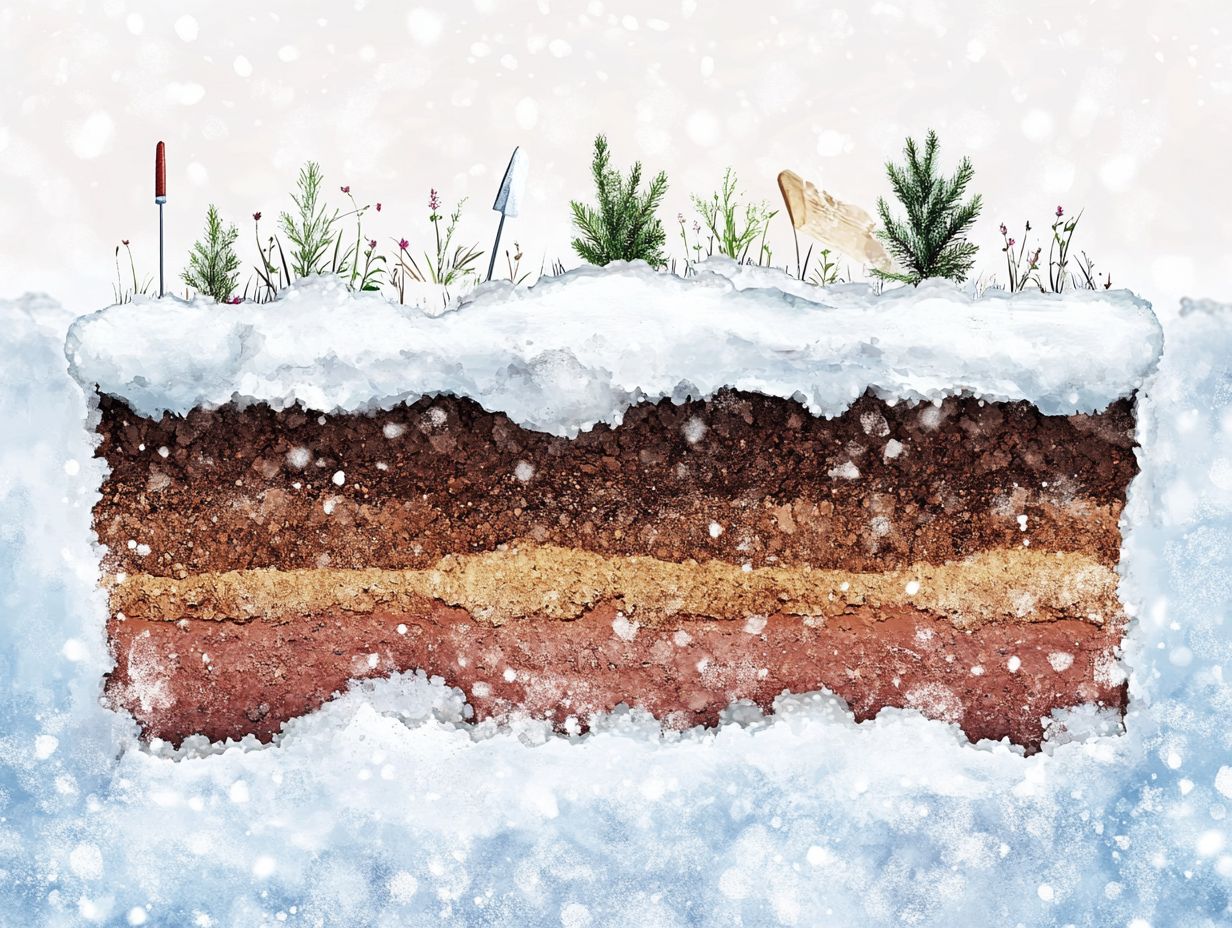
Maintaining soil profiles in cold climates presents several challenges, including frost action, nutrient deficiencies, and soil compaction. Fortunately, the best soil testing labs for cold climates offer effective solutions to mitigate these issues with relative ease.
As a gardener, you might find that harsh winter conditions create ice layers that disrupt plant roots and limit their access to essential nutrients. Implementing frost blankets is an excellent strategy to protect vulnerable plants from extreme temperatures while retaining valuable soil moisture.
Enhancing soil health can be achieved by adjusting your planting techniques. Practices such as crop rotation and the use of cover crops improve nutrient availability and reduce compaction in your garden. By focusing on these practical solutions, you can cultivate a resilient garden environment, ensuring it flourishes even under the most challenging conditions.
Frequently Asked Questions
What materials are needed to build a soil profile for cold climates?
To build a soil profile for cold climates, gather a shovel, a soil testing kit, compost, mulch, and a thermometer. Additionally, consider overcoming soil compaction in cold climates to enhance your gardening efforts.
Why is it important to build a soil profile for cold climates?
Building a soil profile is crucial as it protects plants from harsh winter conditions while allowing for better drainage and aeration, both vital for plant growth. Understanding soil pH in cold climates can further enhance your gardening efforts.
At what time of year should I build a soil profile for cold climates?
The ideal time to create a soil profile for cold climates is in the fall after the growing season. This timing allows the soil to settle and establish before winter temperatures set in, making it crucial to understand soil drainage needs in cold climates.
How do I determine the appropriate depth for each layer in a soil profile for cold climates?
The depth of each layer in a soil profile will depend on the plants you plan to grow. Generally, the topsoil layer should be 6-8 inches deep, followed by a subsoil layer of 8-12 inches and a bottom layer of 12-18 inches.
What type of soil is best for a soil profile in cold climates?
The best type of soil for a soil profile in cold climates is loamy soil, a balanced mixture of sand, silt, and clay. This soil type ensures good drainage and aeration while retaining enough moisture for healthy plant growth. For more insights, check out understanding soil fertility levels in cold climates.
Do I need to add any amendments when building a soil profile for cold climates?
Yes! Adding compost to the topsoil layer is highly recommended as it improves soil structure and provides essential nutrients for plant growth. Also, adding a layer of mulch helps insulate the soil and protects it from freezing temperatures.
Want your garden to thrive even in freezing temperatures? Start applying these techniques today! Building a soil profile not only enhances plant health but also ensures your garden remains resilient against the elements.

